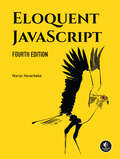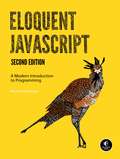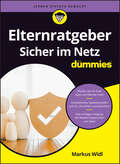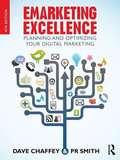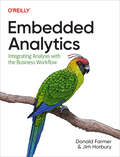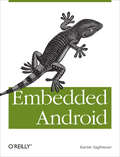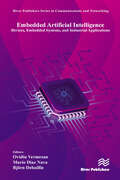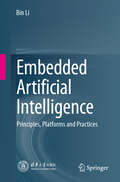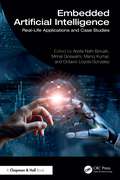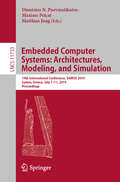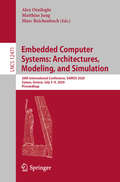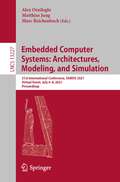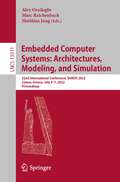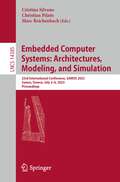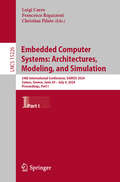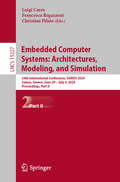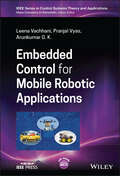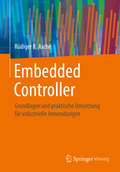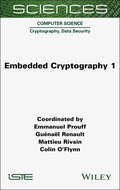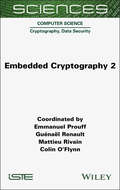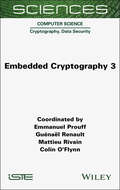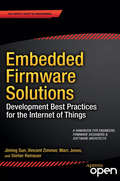- Table View
- List View
Eloquent JavaScript, 4th Edition
by Marijn HaverbekeStart building beautiful web applications in JavaScript with the bestselling introduction to the language, updated with new features, fresh exercises, and fun projects.JavaScript, the programming language that allows us to add programs to web pages, lies at the heart of almost every modern web application, from social media sites to browser-based games. Just about every device can run it, making it a great choice for writing universally useful code.The fourth edition of this classic textbook takes you on a journey through the language of the web, starting from its basic elements and building up to engaging, complete programs. The author&’s personal experiences from years of maintaining popular open source projects enliven the text with practical insights and examples. This edition of Eloquent JavaScript updates the book to describe the 2024 version of JavaScript, and shifts the attention given to some topics to better reflect current development practices.The text takes a practical approach to teaching, rooting theory in plenty of motivating examples. The first half of the book describes the fundamentals of the language, whereas the second half shows how to apply it in two programming environments: the web browser and Node.js. Five project chapters show how to build bigger programs, working through these projects in a piecemeal, conversational way. They include a pathfinding robot, a small programming language, a platform game, a pixel drawing program, and a simple dynamic website.Exercises provided at the end of most chapters will challenge you to creatively apply the concepts and techniques introduced. The book&’s companion website provides an interactive environment for working on these exercises and playing with the example programs.Whether you&’re looking to learn JavaScript or to deepen your programming skills, you&’ll find this book full of stimulating material.Updated to ECMAScript 2024
Eloquent JavaScript: A Modern Introduction to Programming
by Marijn Haverbeke<P>JavaScript is at the heart of almost every modern Web application, whether it's Google Apps, Twitter, or the newest browser-based game. Though it's simple for beginners to pick up and play with, JavaScript is not a toy—it's a flexible and complex language that can be used to build full-scale applications. <P>Eloquent JavaScript dives into this flourishing language and teaches you to write code that's beautiful and effective. By immersing you in example code and encouraging experimentation right from the start, the author quickly gives you the tools you need to build your own programs. As you follow along with examples like an artificial life simulation and a version of the classic game Sokoban, you'll learn to: <br>–Understand the essential elements of programming: syntax, control, and data <br>–Use object-oriented and functional programming techniques to organize and clarify your programs <br>–Script the browser and make basic Web applications <br>–Work with tools like regular expressions and XMLHttpRequest objects <P>And since programming is an art that's best learned by doing, all example code is available online in an interactive sandbox for you to experiment with. With Eloquent JavaScript as your guide, you can tweak, expand, and modify the author's code, or throw it away and build your own creations from scratch. Before you know it, you'll be fluent in the language of the Web.
Eloquent JavaScript: A Modern Introduction to Programming (Second Edition)
by Marijn Haverbeke<P>JavaScript lies at the heart of almost every modern web application, from social apps to the newest browser-based games. Though simple for beginners to pick up and play with, JavaScript is a flexible, complex language that you can use to build full-scale applications. <P>Eloquent JavaScript, 2nd Edition dives deep into the JavaScript language to show you how to write beautiful, effective code. Author Marijn Haverbeke immerses you in example code from the start, while exercises and full-chapter projects give you hands-on experience with writing your own programs. As you build projects such as an artificial life simulation, a simple programming language, and a paint program, you’ll learn: <br>–The essential elements of programming, including syntax, control, and data <br>–How to organize and clarify your code with object-oriented and functional programming techniques <br>–How to script the browser and make basic web applications–How to use the DOM effectively to interact with browsers <br>–How to harness Node.js to build servers and utilities <P>This edition is thoroughly revised and modernized to reflect the current state of JavaScript and web browsers, with brand-new material, such as a chapter on code performance in JavaScript, and expanded coverage of recursion and closures. All source code is available online in an interactive sandbox, where you can edit the code, run it, and see its output instantly. <P>Isn’t it time you became fluent in the language of the Web?
Elternratgeber: Sicher im Netz für Dummies (Für Dummies)
by Markus WidlSichere Mediennutzung begleiten Welche Apps und Dienste fördern und unterhalten Ihr Kind, wo lauert Gefahr? Mit diesem Buch richten Sie Smartphones, Tablets, PCs und Spielekonsolen altersgerecht ein und vermitteln Ihrem Kind fundiert den richtigen Umgang mit (Online-)Medien. Sie verstehen, wie bei Kindern und Jugendlichen verbreitete Apps oder Dienste auf allen gängigen Gerätetypen funktionieren und vernetzt sind. Und wie Sie die Zugriffsmöglichkeiten so steuern, wie Sie es für Ihr Kind für geeignet halten. So kann Ihr Kind sicher surfen, spielen oder soziale Netzwerke nutzen. Sie erfahren Wie Kinder digitale Medien nutzen Was erlaubt ist und was nicht Welche Einstellungen Sie kennen sollten Wie Sie sich und Ihre Kinder vor digitalen Angriffen schützen
Email Discourse Among Chinese Using English as a Lingua Franca
by Yuan-Shan Chen Der-Hwa Victoria Rau Gerald RauThis edited volume makes a valuable contribution to the burgeoning research field of English as a lingua franca. In a pioneering step, the collection is exclusively devoted to the English email discourse of Chinese speakers. The studies address innovative topics related to various contexts and relationships, using several different approaches and theories, which taken together shed light on how English serves as a lingua franca in multiple types of global written communication. The research topics presented are organized into four thematic sections, including emails from students to professors, emails from students to the international academic community, emails from peer to peer, and emails at the workplace. This collection of empirical research invites readers to consider the special features of apologies, requests, terms of address, politeness, and discourse organization, and how cultural differences may affect the use or interpretation of each. Throughout the book, readers will also discover how Chinese speakers use special features and strategies to construct their identity, establish relationships, and achieve successful communication in English. This highly informative, thought-provoking book also provides insights on methods for teaching email discourse using English as a lingua franca and suggests directions for future research.
Email and the Everyday: Stories of Disclosure, Trust, and Digital Labor
by Esther MilneAn exploration of how email is experienced, understood, and materially structured as a practice spanning our everyday domestic and work lives.Despite its many obituaries, email is not dead. As a global mode of business and personal communication, email outstrips newer technologies of online interaction; it is deeply embedded in our everyday lives. And yet--perhaps because the ubiquity of email has obscured its study--this is the first scholarly book devoted to email as a key historical, social, and commercial site of digital communication in our everyday lives. In Email and the Everyday, Esther Milne examines how email is experienced, understood, and materially structured as a practice spanning the domestic and institutional spaces of daily life.
Emarketing Excellence: Planning and Optimizing your Digital Marketing
by Pr Smith Dave ChaffeyNow in its fourth edition, the hugely successful Emarketing Excellence is fully updated; keeping you in line with the changes in this dynamic and exciting field and helping you create effective and up-to-date customer-centric e-marketing plans. A practical guide to creating and executing e-marketing plans, it combines established approaches to marketing planning with the creative use of new e-models and e-tools. This new edition seamlessly integrates social media technology like Facebook check-in, social networking, tablets and mobile applications into the mix, demonstrating how these new ways to reach customers can be integrated into your marketing plans. It also includes brand new sections on online marketing legislation and QR codes, plus an expanded section on email marketing, the most commonly used e-marketing tool. Offering a highly structured and accessible guide to a critical and far-reaching subject, Emarketing Excellence 4e provides a vital reference point for all students of business or marketing and marketers and e-marketers involved in marketing strategy and implementation and who want a thorough yet practical grounding in e-marketing.
Embedded Analytics: Integrating Analysis with the Business Workflow
by Donald Farmer Jim HorburyOver the past 10 years, data analytics and data visualization have become essential components of an enterprise information strategy. And yet, the adoption of data analytics has remained remarkably static, reaching no more than 30% of potential users. This book explores the most important techniques for taking that adoption further: embedding analytics into the workflow of our everyday operations.Authors Donald Farmer and Jim Horbury show business users how to improve decision making without becoming analytics specialists. You'll explore different techniques for exchanging data, insights, and events between analytics platforms and hosting applications. You'll also examine issues including data governance and regulatory compliance and learn best practices for deploying and managing embedded analytics at scale.Learn how data analytics improves business decision making and performanceExplore advantages and disadvantages of different embedded analytics platformsDevelop a strategy for embedded analytics in an organization or productDefine the architecture of an embedded solutionSelect vendors, platforms, and tools to implement your architecture Hire or train developers and architects to build the embedded solutions you needUnderstand how embedded analytics interacts with traditional analytics
Embedded Android
by Karim Yaghmour<p>Embedded Android is for Developers wanting to create embedded systems based on Android and for those wanting to port Android to new hardware, or creating a custom development environment. Hackers and moders will also find this an indispensible guide to how Android works.</p>
Embedded Artificial Intelligence: Devices, Embedded Systems, and Industrial Applications
by Ovidiu Vermesan Mario Diaz Nava Björn DebaillieRecent technological developments in sensors, edge computing, connectivity, and artificial intelligence (AI) technologies have accelerated the integration of data analysis based on embedded AI capabilities into resource-constrained, energy-efficient hardware devices for processing information at the network edge. Embedded AI combines embedded machine learning (ML) and deep learning (DL) based on neural networks (NN) architectures such as convolutional NN (CNN), or spiking neural network (SNN) and algorithms on edge devices and implements edge computing capabilities that enable data processing and analysis without optimised connectivity and integration, allowing users to access data from various sources. Embedded AI efficiently implements edge computing and AI processes on resource-constrained devices to mitigate downtime and service latency, and it successfully merges AI processes as a pivotal component in edge computing and embedded system devices. Embedded AI also enables users to reduce costs, communication, and processing time by assembling data and by supporting user requirements without the need for continuous interaction with physical locations. This book provides an overview of the latest research results and activities in industrial embedded AI technologies and applications, based on close cooperation between three large-scale ECSEL JU projects, AI4DI, ANDANTE, and TEMPO. The book’s content targets researchers, designers, developers, academics, post-graduate students and practitioners seeking recent research on embedded AI. It combines the latest developments in embedded AI, addressing methodologies, tools, and techniques to offer insight into technological trends and their use across different industries.
Embedded Artificial Intelligence: Principles, Platforms and Practices
by Bin LiThis book focuses on the emerging topic of embedded artificial intelligence and provides a systematic summary of its principles, platforms, and practices. In the section on principles, it analyzes three main approaches for implementing embedded artificial intelligence: cloud computing mode, local mode, and local-cloud collaborative mode. The book identifies five essential components for implementing embedded artificial intelligence: embedded AI accelerator chips, lightweight neural network algorithms, model compression techniques, compiler optimization techniques, and multi-level cascaded application frameworks. The platform section introduces mainstream embedded AI accelerator chips and software frameworks currently used in the industry. The practical part outlines the development process of embedded artificial intelligence and showcases real-world application examples with accompanying code. As a comprehensive guide to the emerging field of embedded artificial intelligence, the book offers rich and in-depth content, a clear and logical structure, and a balanced approach to both theoretical analysis and practical applications. It provides significant reference value and can serve as an introductory and reference guide for researchers, scholars, students, engineers, and professionals interested in studying and implementing embedded artificial intelligence.
Embedded Artificial Intelligence: Real-Life Applications and Case Studies
by Manoj Kumar Octavio Loyola-González Mrinal Goswami Arpita Nath BoruahThis book explores the role of embedded AI in revolutionizing industries such as healthcare, transportation, manufacturing, and retail. It begins by introducing the fundamentals of AI and embedded systems and specific challenges and opportunities. A key focus of this book is developing efficient and effective algorithms and models for embedded AI systems, as embedded systems have limited processing power, memory, and storage. It discusses a variety of techniques for optimizing algorithms and models for embedded systems, including hardware acceleration, model compression, and quantization.Key features: Explores security experiments in emerging post‑CMOS technologies using AI, including side channel attack‑resistant embedded systems Discusses different hardware and software platforms available for developing embedded AI applications, as well as the various techniques used to design and implement these systems Considers ethical and societal implications of embedded AI vis‑a‑vis the need for responsible development and deployment of embedded AI systems Focuses on application‑based research and case studies to develop embedded AI systems for real‑life applications Examines high‑end parallel systems to run complex AI algorithms and comprehensive functionality while maintaining portability and power efficiency This reference book is for students, researchers, and professionals interested in embedded AI and relevant branches of computer science, electrical engineering, or artificial intelligence.
Embedded Computer Systems: 19th International Conference, SAMOS 2019, Samos, Greece, July 7–11, 2019, Proceedings (Lecture Notes in Computer Science #11733)
by Maxime Pelcat Matthias Jung Dionisios N. PnevmatikatosThis book constitutes the refereed proceedings of the 19th International Conference on Embedded Computer Systems: Architectures, Modeling, and Simulation, SAMOS 2019, held in Pythagorion, Samos, Greece, in July 2019.The 21 regular papers presented were carefully reviewed and selected from 55 submissions. The papers are organized in topical sections on system design space exploration; deep learning optimization; system security; multi/many-core scheduling; system energy and heat management; many-core communication; and electronic system-level design and verification. In addition there are 13 papers from three special sessions which were organized on topics of current interest: insights from negative results; machine learning implementations; and European projects.
Embedded Computer Systems: 20th International Conference, SAMOS 2020, Samos, Greece, July 5–9, 2020, Proceedings (Lecture Notes in Computer Science #12471)
by Alex Orailoglu Matthias Jung Marc ReichenbachThis book constitutes the refereed proceedings of the 20th International Conference on Embedded Computer Systems: Architectures, Modeling, and Simulation, SAMOS 2020, held in Samos, Greece, in July 2020.*The 16 regular papers presented were carefully reviewed and selected from 35 submissions. In addition, 9 papers from two special sessions were included, which were organized on topics of current interest: innovative architectures for security and European projects on embedded and high performance computing for health applications. * The conference was held virtually due to the COVID-19 pandemic.
Embedded Computer Systems: 21st International Conference, SAMOS 2021, Virtual Event, July 4–8, 2021, Proceedings (Lecture Notes in Computer Science #13227)
by Alex Orailoglu Matthias Jung Marc ReichenbachThis book constitutes the proceedings of the 21st International Conference on Embedded Computer Systems: Architectures, Modeling, and Simulation, SAMOS 2021, which took place in July 2021. Due to COVID-19 pandemic the conference was held virtually. The 17 full papers presented in this volume were carefully reviewed and selected from 45 submissions. The papers are organized in topics as follows: simulation and design space exploration; the 3Cs - Cache, Cluster and Cloud; heterogeneous SoC; novel CPU architectures and applications; dataflow; innovative architectures and tools for security; next generation computing; insights from negative results.
Embedded Computer Systems: 22nd International Conference, SAMOS 2022, Samos, Greece, July 3–7, 2022, Proceedings (Lecture Notes in Computer Science #13511)
by Alex Orailoglu Matthias Jung Marc ReichenbachThis book constitutes the proceedings of the 22st International Conference on Embedded Computer Systems: Architectures, Modeling, and Simulation, SAMOS 2021, which took place in July 2022 in Samos, Greece. The 21 full papers presented in this volume were carefully reviewed and selected from 44 submissions. The papers are organized in topics as follows: High level synthesis; memory systems; processor architecture; embedded software systems and beyond; deep learning optimization; extra-functional property estimation; innovative architectures and tools for security; european research projects on digital systems, services, and platforms.
Embedded Computer Systems: 23rd International Conference, SAMOS 2023, Samos, Greece, July 2–6, 2023, Proceedings (Lecture Notes in Computer Science #14385)
by Cristina Silvano Marc Reichenbach Christian PilatoThis book constitutes the proceedings of the 22st International Conference on Embedded Computer Systems: Architectures, Modeling, and Simulation, SAMOS 2021, which took place in July 2022 in Samos, Greece. The 11 full papers and 7 short papers presented in this volume were carefully reviewed and selected from 45 submissions. The conference covers a wide range of embedded systems design aspects, including machine learning accelerators, and power management and programmable dataflow systems.
Embedded Computer Systems: 24th International Conference, SAMOS 2024, Samos, Greece, June 29 – July 4, 2024, Proceedings, Part I (Lecture Notes in Computer Science #15226)
by Luigi Carro Francesco Regazzoni Christian PilatoThe two-volume set LNCS 15226 and 15227 constitutes the refereed proceedings of the 24th International Conference on Embedded Computer Systems: Architectures, Modeling, and Simulation, SAMOS 2024, held in Samos, Greece, during June 29–July 4, 2024. The 24 full papers, 10 full papers in 2 special sessions and 4 poster session included in this book were carefully reviewed and selected from 57 submissions. This SAMOS 2024 covers the topics systems themselves - through their applications; architectures; and underlying processors - or methods created to automate their design.
Embedded Computer Systems: 24th International Conference, SAMOS 2024, Samos, Greece, June 29 – July 4, 2024, Proceedings, Part II (Lecture Notes in Computer Science #15227)
by Luigi Carro Francesco Regazzoni Christian PilatoThe two-volume set LNCS 15226 and 15227 constitutes the refereed proceedings of the 24th International Conference on Embedded Computer Systems: Architectures, Modeling, and Simulation, SAMOS 2024, held in Samos, Greece, during June 29–July 4, 2024. The 24 full papers, 10 invited full papers and 4 poster papers included in the proceedings were carefully reviewed and selected from 57 submissions. They deal with embedded computer systems focusing on their applications; architectures; and underlying processors, as well as methods created to automate their design.
Embedded Control for Mobile Robotic Applications (IEEE Press Series on Control Systems Theory and Applications)
by Leena Vachhani Pranjal Vyas Arunkumar G. K.An all-in-one resource for designing and implementing embedded control in mobile robotics In Embedded Control for Mobile Robotic Applications, a distinguished trio of researchers delivers an authoritative and fulsome resource for understanding embedded control and robotics. The book includes coverage of a variety of embedded platforms, their use in controller implementation, stability analyses of designed controllers, and two new approaches for designing embedded controllers. The authors offer a full chapter on Field-Programmable-Gate-Array (FPGA) architecture development for controller design that is perfect for both practitioners and students taking robotics courses and provide a companion website that includes MATLAB codes for simulation and embedded platform-specific code for mobile robotic applications (in Embedded C and Verilog). The two approaches discussed by the authors—the top-down methodology and the bottom-up methodology—are of immediate practical utility to both practicing professionals in the field and students studying control applications and mobile robotics. The book also offers: A thorough introduction to embedded control, including processor, IC, and design technology, as well as a discussion of limitations in embedded control design Comprehensive explorations of the bottom-up and top-down methods, including computations using CORDIC, interval arithmetic, sliding surface design, and switched nonlinear systems Practical discussions of generic FPGA architecture design, including Verilog, PID controllers, DC motors and Encoder, and a systematic approach for designing architecture using FSMD In-depth examinations of discrete-time controller design, including the approximation to discrete-time transfer function and embedded implementation stability Perfect for practitioners working in embedded control design and control applications in robotics, Embedded Control for Mobile Robotic Applications will also earn a place in the libraries of academicians, researchers, senior undergraduate students, and graduate students in these fields.
Embedded Controller: Grundlagen und praktische Umsetzung für industrielle Anwendungen
by Rüdiger R. AscheDas Buch gewährt einen Einblick in die Architektur eingebetteter Systeme und den Entwicklungsprozess für die sie steuernde Firmware. Die Anforderungen an ein unbeaufsichtigt laufendes Embedded System sowie deren Umsetzung stehen dabei im Fokus. Alle Konzepte werden anhand von verbreiteten Komponenten wie ARM® Cortex® M3 und M4 basierten Prozessoren, FreeRTOS oder lwip praktisch umgesetzt. Praxistipps zur effizienten und zielgerichteten Nutzung von Debug-, Einkapselungs- und Analysewerkzeugen runden das Buch ab. Sie helfen sowohl dem Einsteiger als auch dem erfahrenen Profi bei der Entwicklung robuster und wartungsfreundlicher Firmware für Mikrocontroller im eingebetteten Umfeld.
Embedded Cryptography 1 (ISTE Invoiced)
by Emmanuel Prouff Colin O'Flynn Guenael Renault Mattieu RivainEmbedded Cryptography provides a comprehensive exploration of cryptographic techniques tailored for embedded systems, addressing the growing importance of security in devices such as mobile systems and IoT. The books explore the evolution of embedded cryptography since its inception in the mid-90s and cover both theoretical and practical aspects, as well as discussing the implementation of cryptographic algorithms such as AES, RSA, ECC and post-quantum algorithms. The work is structured into three volumes, spanning forty chapters and nine parts, and is enriched with pedagogical materials and real-world case studies, designed for researchers, professionals, and students alike, offering insights into both foundational and advanced topics in the field. Embedded Cryptography 1 is dedicated to software side-channel attacks, hardware side-channel attacks and fault injection attacks.
Embedded Cryptography 2 (ISTE Invoiced)
by Emmanuel Prouff Colin O'Flynn Guenael Renault Mattieu RivainEmbedded Cryptography provides a comprehensive exploration of cryptographic techniques tailored for embedded systems, addressing the growing importance of security in devices such as mobile systems and IoT. The books explore the evolution of embedded cryptography since its inception in the mid-90s and cover both theoretical and practical aspects, as well as discussing the implementation of cryptographic algorithms such as AES, RSA, ECC and post-quantum algorithms. The work is structured into three volumes, spanning forty chapters and nine parts, and is enriched with pedagogical materials and real-world case studies, designed for researchers, professionals, and students alike, offering insights into both foundational and advanced topics in the field. Embedded Cryptography 2 is dedicated to masking and cryptographic implementations, as well as hardware security.
Embedded Cryptography 3 (ISTE Invoiced)
by Emmanuel Prouff Colin O'Flynn Guenael Renault Mattieu RivainEmbedded Cryptography provides a comprehensive exploration of cryptographic techniques tailored for embedded systems, addressing the growing importance of security in devices such as mobile systems and IoT. The books explore the evolution of embedded cryptography since its inception in the mid-90s and cover both theoretical and practical aspects, as well as discussing the implementation of cryptographic algorithms such as AES, RSA, ECC and post-quantum algorithms. The work is structured into three volumes, spanning forty chapters and nine parts, and is enriched with pedagogical materials and real-world case studies, designed for researchers, professionals, and students alike, offering insights into both foundational and advanced topics in the field. Embedded Cryptography 3 is dedicated to white-box cryptography, randomness and key generation, as well as real world applications and attacks in the wild.
Embedded Firmware Solutions: Development Best Practices for the Internet of Things
by Jiming Sun Marc Jones Stefan Reinauer Vincent ZimmerEmbedded Firmware Solutions is the perfect introduction and daily-use field guide--for the thousands of firmware designers, hardware engineers, architects, managers, and developers--to Intel's new firmware direction (including Quark coverage), showing how to integrate Intel(R) Architecture designs into their plans. Featuring hands-on examples and exercises using Open Source codebases, like Coreboot and EFI Development Kit (tianocore) and Chromebook, this is the first book that combines a timely and thorough overview of firmware solutions for the rapidly evolving embedded ecosystem with in-depth coverage of requirements and optimization.
